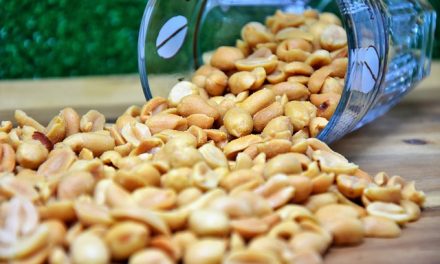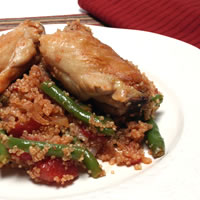Sections in the Article:
- How Can I Control My Diabetes?
- How Can I Eat Healthy?
- Starches
- Vegetables
- Fruits
- Milk and Yogurt
- Protein
- Fats and Oils
- Sugary Foods
- The Food Pyramid
- Points To Remember
- How To Find More Help
How Can I Control My Diabetes
You can help control your blood sugar (also called blood glucose) and diabetes when you eat healthy, get enough exercise, and stay at a healthy weight.
A healthy weight also helps you control your blood fats and lower your blood pressure.
Many people with diabetes also need to take medicine to help control their blood sugar.
How Can I Eat Healthy?
Using the food pyramid helps you eat a variety of healthy foods. When you eat different foods, you get the vitamins and minerals you need.

Eat different foods from each group each day. See how to do this in the example below.
|
What Are Starches?
Starches are bread, grains, cereal, pasta, or starchy vegetables. Eat some starches at each meal. People might tell you not to eat many starches, but that is no longer correct advice. Eating starches is healthy for everyone, including people with diabetes.

The number of servings you should eat each day depends on
- The calories you need.
- Your diabetes treatment plan.
Starches give your body energy, vitamins and minerals, and fiber. Whole grain starches are healthier because they have more vitamins, minerals, and fiber. Fiber helps you have regular bowel movements.
How Much Is a Serving of Starch?
1 Serving:

2 Servings:

3 Servings:

You might need to eat one, two, or three starch servings at a meal. If you need to eat more than one serving at a meal, choose several different starches or have two or three servings of one starch.
What Are Healthier Ways to Buy, Cook, and Eat Starches?
- Buy whole grain breads and cereals.
- Eat fewer fried and high-fat starches such as regular tortilla chips and potato chips, french fries, pastries, biscuits, or muffins.
- Use low-fat or fat-free yogurt or fat-free sour cream instead of regular sour cream on a baked potato.
- Use mustard instead of mayonnaise on a sandwich.
- Use the low-fat or fat-free substitutes such as low-fat mayonnaise or light margarine on bread, rolls, or toast.
- Use vegetable oil spray instead of oil, shortening, butter, or margarine.
- Cook or eat cereal with fat-free (skim) or low-fat (1%) milk.
- Use no-sugar jelly, low-fat or fat-free cottage cheese, nonfat yogurt, or salsa.
Vegetables are healthy for everyone, including people with diabetes. Eat raw and cooked vegetables every day. Vegetables give you vitamins, minerals, and fiber, with very few calories.
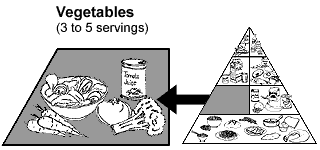
The number of servings you should eat each day depends on
- The calories you need.
- How you take care of your diabetes.
How Much Is a Serving of Vegetables?
1 Serving:
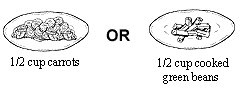
2 Servings:

3 Servings:

You might need to eat one, two, or three vegetable servings at a meal. If you need to eat more than one serving at a meal, choose a few different types of vegetables or have two or three servings of one vegetable.
What Are Healthier Ways To Buy, Cook, and Eat Vegetables?
Eat raw and cooked vegetables with little or no fat. You can cook and eat vegetables without any fat.
- Try low-fat or fat-free salad dressing on raw vegetables or salads.
- Steam vegetables using a small amount of water or low-fat broth.
- Mix in some chopped onion or garlic.
- Use a little vinegar or some lemon or lime juice.
- Add a small piece of lean ham or smoked turkey.
- Sprinkle with herbs and spices. These flavorings add almost no fat or calories.
If you do use a small amount of fat, use canola oil, olive oil, or tub margarine instead of fat from meat, butter, or shortening.
What Are Fruits?
Fruit is healthy for everyone, including people with diabetes. Fruit gives you energy, vitamins and minerals, and fiber.
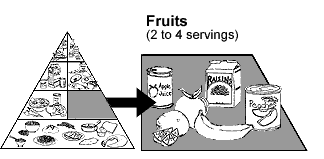
The number of servings you should eat each day depends on
- The calories you need.
- How you take care of your diabetes.
How Much Is a Serving of Fruit?
1 Serving:
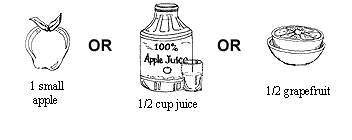
2 Servings:
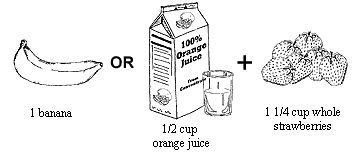
You might need to eat one or two fruit servings at a meal. If you need to eat more than one serving at a meal, choose different types of fruits or have two servings of one fruit.
How Should I Eat Fruit?
Eat fruits raw, as juice with no sugar added, canned in their own juice, or dried.
- Buy smaller pieces of fruit.
- Eat pieces of fruit rather than drinking fruit juice. Pieces of fruit are more filling.
- Buy fruit juice that is 100-percent juice with no added sugar.
- Drink fruit juice in small amounts.
- Save high-sugar and high-fat fruit desserts such as peach cobbler or cherry pie for special occasions.
What Are Milk and Yogurt Foods?
Fat-free and low-fat milk and yogurt are healthy for everyone, including people with diabetes. Milk and yogurt give you energy, protein, calcium, vitamin A, and other vitamins and minerals.
Drink fat-free (skim or nonfat) or low-fat (1%) milk each day. Eat low-fat or fat-free yogurt. They have less total fat, saturated fat, and cholesterol.
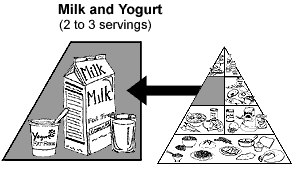
The number of servings you should eat each day depends on
- The calories you need.
- How you take care of your diabetes.
Note: If you are pregnant or breastfeeding, eat four to five servings of milk and yogurt each day.
How Much Is a Serving of Milk and Yogurt?
1 Serving:
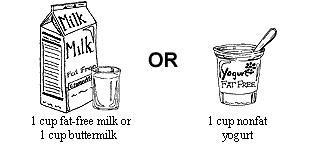
What Are Protein Foods?
Protein foods are meat, poultry, eggs, cheese, fish, and tofu. Eat small amounts of some of these foods each day.
Protein foods help your body build tissue and muscles. They also give your body vitamins and minerals.
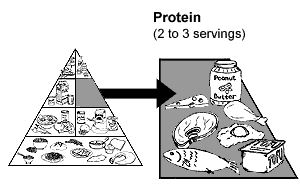
The number of servings you should eat each day depends on
- The calories you need.
- How you take care of your diabetes.
How Much Is a Serving of Protein Food?
1 Serving:

The serving size you eat now may be too big.
One serving should weigh between 2 and 3 ounces after cooking, about the size of a deck of cards.
What Are Healthier Ways To Buy, Cook, and Eat Protein Foods?
- Buy cuts of beef, pork, ham, and lamb that have only a little fat on them. Trim off extra fat.
- Eat chicken or turkey without the skin.
- Cook protein foods in low-fat ways:
- Broil.
- Grill.
- Stir-fry.
- Roast.
- Steam.
- Stew.
- To add more flavor, use vinegars, lemon juice, soy or teriyaki sauce, salsa, ketchup, barbecue sauce, and herbs and spices.
- Cook eggs with a small amount of fat.
- Eat small amounts of nuts, peanut butter, fried chicken, fish, or shellfish. They are high in fat.
What Are Fats and Oils?
You find the fats and oils section at the tip of the pyramid. This tells you to eat small amounts of fats and oils because they have lots of calories. Some fats and oils also contain saturated fats and cholesterol that are not good for you.
You also get fat from other foods such as meats and some dairy foods.
High-fat food is tempting. But eating small amounts of high-fat food will help you lose weight, keep your blood sugar and blood fats under control, and lower your blood pressure.
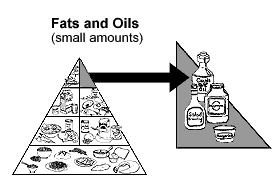
How Much Is a Serving of Fat or Oil?
1 Serving:
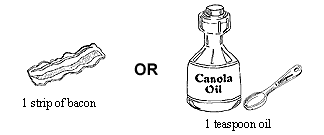
2 Servings:

Your meals may include one or two servings of fat.
What Are Sugary Foods?
You find the sugary foods and sweets section at the tip of the pyramid. This tells you to eat small amounts of sugary foods.
Sugary foods have calories and do not have much nutrition. Sugary foods have lots of calories. Some sugary foods are also high in fat--like cakes, pies, and cookies. They also may contain saturated fats and cholesterol.
Sugary foods and sweets are tempting. But eating small amounts of sugary foods will help you lose weight, keep your blood sugar under control, control your blood fats, and lower your blood pressure.
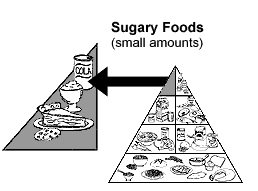
How Much Is a Serving of Sugary Foods and Sweets?
1 Serving:
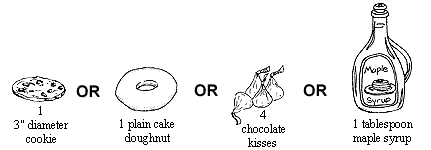
Once in a while you can eat a serving of a sugary food. Talk to your diabetes teacher about how to fit sugary foods into your meal plan.
How Can I Satisfy My Sweet Tooth?
Eat a serving of sugar-free popsicles, diet soda, fat-free ice cream or yogurt, or sugar-free hot cocoa mix once in a while.
Remember, fat-free and low-sugar foods still have some calories. Eat them as part of your meal plan.
The Food Pyramid

To follow a healthy eating plan
- Choose foods from all six food groups each day.
- Eat a wide variety of foods from each group to get all your vitamins and minerals.
- Eat enough starches, vegetables, fruits, and low-fat milk and yogurt.
- Eat smaller amounts of lower fat protein foods.
- Eat fewer fats, oils, and sugary foods.
NDIC/NIDDK


